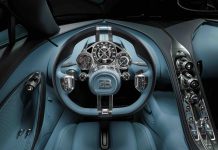There’s an old slam that says Japanese car companies are better at imitating than innovating.
Then how to explain the Lexus RX?
When this model first appeared way back in late 1998, it was unlike anything else being offered by a luxury car maker at the time. It singlehandedly defined a whole new category of vehicle – what we now call “luxury crossovers” – and quickly became a monster hit for Lexus.
In the years since the introduction of the RX, a cattle call of imitators have scrambled onto the field – including home team models like the Caddy SRX and Lincoln MKX, the German-built BMW X5 and Audi Q5 – as well as other Japanese models like the sporty Infiniti FX and Acura MDX.
Clearly, Lexus was onto something back then.
But, is the current RX still top dog today?
WHAT IT IS
The RX350 is a medium-sized, five-passenger luxury crossover wagon.
Prices begin at $38,375 for the FWD version and run to $39,775 for one equipped with the optional AWD system. (There’s also a hybrid version of the RX – the RX450h. Its base price is $43,935.)
WHAT’S NEW FOR 2011
The RX was completely redesigned last year, so the 2011 model is pretty much a carryover with the main difference between the 2010 and the 2011 being an inflation-adjusted $1,575 uptick in the RX’s price. Last year’s RX started at $36,800.
Thanks, Fed.
WHAT’S GOOD
Comes in one already well-appointed trim, with the major big ticket extra being AWD.
Comes in below the sticker price of the $39,375 to start Lincoln MKX.
Has much better acceleration than the $10k more expensive Cadillac SRX turbo ($49,915).
Very low depreciation rates.
Absolutely outstanding new-design ergonomic interface for the optional GPS/audio system.
WHAT’S NOT SO GOOD
Several options are bundled together into expensive packages that force you to buy a whole bunch of stuff to get the one or two things you actually wanted. Of course, they all do this….
The (grossly unfair) “Sudden Unintended Acceleration II: The Sequel” debacle of last summer has damaged Toyota’s (and thus Lexus’) formerly sterling reputation, which may hurt those historically high resale values.
UNDER THE HOOD
All 2011 RXs come with a 275 hp 3.5 liter V-6, bumped up 5 hp from the previous 270 hp V-6.
Another upgrade is the new – and also standard – six-seed automatic transmission, which replaces the previous model’s five-speed automatic.
This new, more efficient transmission helps the ’11 RX get slightly better gas mileage on the highway than the previous version – despite the current model being more powerful and heavier by several hundred pounds.
EPA rates the 2011 RX350 with FWD at 18 mpg city and 25 mpg highway vs. 18 city, 23 highway for the old RX.
The 2011 RX is also a little bit quicker than the previous model RX.
It runs the 0-60 sprint in about 7.1-7.3 seconds, depending on whether it’s the FWD or the (slightly heavier) AWD version. That’s about 1-2 tenths of a second quicker than before. It’s not a huge difference, but the fact that the new RX didn’t lose a step (due to its higher curb weight) while still managing to return slightly better highway gas mileage is nonetheless appreciated.
The RX is also about a tenth or two quicker to 60 than the Lincoln MKX and much quicker than the Cadillac SRX, which needs 8 seconds to get there, even with its optional (and expensive) turbo 2.8 liter engine. Equipped with its standard engine, the Cadillac is a solid second behind the RX, 0-60.
Maximum tow rating for the Lexus is 3,500 pounds – the same as before and par for the segment.
ON THE ROAD
The RX is no longer the only game in town and several other models, most especially the Lincoln MKX and the Cadillac SRX, ride/handle and drive like the RX – combing the higher ride height of an SUV with the gentle road manners of a top-of-the-line luxury sedan.
But the RX is still the one to match – and to beat.
The MKX comes close, acceleration-wise, but its handling/ride quality isn’t quite as dialed in. There’s more body roll in the corners and it feels top-heavier …. because it is top-heavier. The Lincoln sits almost 8 inches off the pavement – and it’s heavier (4,400-plus lbs. with AWD) than the RX.
The Caddy SRX’s ride, on the other hand, is similarly plush – no doubt because of the luxury-minded suspension tuning but also because, like the RX, the SRX sits fairly low to the ground (for a crossover) and it weighs about the same.
In fact, the Caddy sits lower to the ground than the RX – 7.0 inches vs. 7.3 for the RX – which puts its center of gravity that much closer to the pavement, which in turn imparts that much-desired car-like feel. But the Cadillac’s acceleration is soft, too – borderline slow, actually – for a vehicle that costs almost $50,000. For that kind of money, you should be able to effortlessly walk away from $20,000 economy cars. Instead, they can easily keep pace with you.
In the SRX, anyhow.
So the Lexus still comes out on top. It has the same ying-yang nearly perfect mix of athleticism/poise and serenity/quiet that made the original 1999 model so instantly appealing. The imitators are working hard to deliver the same experience, but they’re still falling short one way or another.
AT THE CURB
Overall, the new RX is slightly longer and wider than the previous RX, which translates into slightly more stretching out space in some categories such as shoulder room for both front and second row occupants. However, there’s also slightly less front seat headroom (39.1 inches vs. 39.3 before) and total cargo capacity is slightly less now, at 80.3 cubic feet (with the second row folded) vs. 85 cubic feet before.
Still, this is a lot more cargo room than in either the SRX (61.1 cubic feet) or the MKX (68.6).
Interestingly the RX also has significantly more front seat legroom (43.1 inches) than either the SRX (41.2 inches) or the Lincoln MKX (40.7 inches), despite being physically only slightly longer nose to tail than the MKX (187.8 inches vs. 186.7 inches) and 2.5 inches shorter, overall, than the Cadillac (190.3 inches).
The MKX does have about 3 inches more second-row legroom than either the Lexus or the Cadillac, as well as about an inch more side-to-side (shoulder) room.
But one thing no competitor can touch the RX on is the new Remote Touch multifunctional controller that works the GPS/climate and audio systems. 
Instead of a makes-you-want-to-smash-something “mouse” or a keypad of chiclet-sized buttons to drive up your blood pressure as you try to drive the car, there’s an elegantly ergonomic, hand-shaped pad on top of the RX’s center console. A large toggle switch toward the front works like a cursor; there’s a click button on the left side of the pad located right where your thumb naturally falls. Use the toggle to select “Climate” or Audio” and then work through the menu options presented on the LCD display by pushing the side button with your thumb. Just two main inputs to work – vs. two or three times that many in some of the worst systems out there.
The Lexus system is immediately comprehensible, too. No exasperating “learning curve,” no manuals to pore over. Just get in and drive.
It’s a home-run design that addresses the very real problem of too much “control clutter” – and too much potential distraction – associated with the electronics that are now commonly found in all luxury cars.
THE REST
The RX is (and always has been) a beautifully finished vehicle; first-class materials – and first-class workmanship. It has also enjoyed very high resale values. Ten year old RX300s are still worth as much as $9,000 on used car lots – about a third of what they cost brand-new.
Not many (if any) of the RX’s competitors can match that kind of financial staying power.
You also get ten standard air bags – including dual front knee bags (not just a driver’s side knee bag). Shop some other brands and you have to buy a flagship model that costs sixty or even seventy thousand dollars to get that level of protection.
The main safety-related optional stuff is the back-up camera (bundled with GPS), a side monitor (bundled with the Luxury Package) and, of course, the all-wheel-drive system. An electronically locking differential is available with the AWD, but like other luxury crossovers, the RX is not built for rugged off-roading. The AWD may be helpful to have in the snow, but for most people, the standard FWD model – with a good set of tires – will get you there (and back) just as well.
The updated exterior is slightly more macho than before but not aggressively so. The grille is more angular and wedge-like; the headlight assemblies narrower and more feline. There’s also a scalloped cut-line pressed into the lower rocker panels on the side – with a more pronounced crease along the tops of the doors that runs from the end of the headlights all the way to the rear.
But unless you park a new RX next to an older version, the differences between this and previous generations are pretty subtle and not immediately obvious. This design ethic of gradual change within the boundaries of a given “look” helps explain why all RX models over the years have aged so gracefully. The original ’99 model still looks current – in much the same way that an ’80s-era Jaguar XJ still looked up-to-date even in the late 1990s.
I don’t know this for a fact, but I’d guess that many RX owners appreciate a vehicle that won’t look so ancient that it needs to be hooked up to an oxygen tank just four or five years after you drive it home.
Another nice little detail: There’s a piggyback-style power plug extender on a short cord that feeds from the center console storage well. This makes it easier to plug in accessories vs. trying to find/fit the outlet when it’s buried deep inside the console.
And: there’s an extra cupholder built into the top left of the dash, to the left of the steering wheel. I find this location to be better in every respect than the center console-mounted cupholders most vehicles have (and which the RX does, too). The location is in the driver’s line of sight, so you can get your drink (and replace it) without looking down and to the right. Plus, if you spill, it won’t gunk up the shifter/console.
The dial-style twin controls for the seat heaters/coolers are also extremely ergonomic and well thought-out.
These and countless other “little things” are among the reasons why the RX such a pleasure to own and drive – and help to explain its ongoing popularity.
THE BOTTOM LINE
While the RX has more competition than ever, it still delivers the luxury crossover goods as single-mindedly – and nearly perfectly – as that first-year model did.










